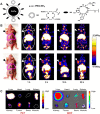Radiolabeled nanoparticles for multimodality tumor imaging
- PMID: 24505237
- PMCID: PMC3915092
- DOI: 10.7150/thno.7341
Radiolabeled nanoparticles for multimodality tumor imaging
Abstract
Each imaging modality has its own unique strengths. Multimodality imaging, taking advantages of strengths from two or more imaging modalities, can provide overall structural, functional, and molecular information, offering the prospect of improved diagnostic and therapeutic monitoring abilities. The devices of molecular imaging with multimodality and multifunction are of great value for cancer diagnosis and treatment, and greatly accelerate the development of radionuclide-based multimodal molecular imaging. Radiolabeled nanoparticles bearing intrinsic properties have gained great interest in multimodality tumor imaging over the past decade. Significant breakthrough has been made toward the development of various radiolabeled nanoparticles, which can be used as novel cancer diagnostic tools in multimodality imaging systems. It is expected that quantitative multimodality imaging with multifunctional radiolabeled nanoparticles will afford accurate and precise assessment of biological signatures in cancer in a real-time manner and thus, pave the path towards personalized cancer medicine. This review addresses advantages and challenges in developing multimodality imaging probes by using different types of nanoparticles, and summarizes the recent advances in the applications of radiolabeled nanoparticles for multimodal imaging of tumor. The key issues involved in the translation of radiolabeled nanoparticles to the clinic are also discussed.
Keywords: cancer; molecular imaging; multimodality imaging; radiolabeled nanoparticles; theranostics; tumor diagnosis.
Conflict of interest statement
Competing Interests: The authors have declared that no competing interest exists.
Figures







Similar articles
-
Exploring innovative strides in radiolabeled nanoparticle progress for multimodality cancer imaging and theranostic applications.Cancer Imaging. 2024 Sep 20;24(1):127. doi: 10.1186/s40644-024-00762-z. Cancer Imaging. 2024. PMID: 39304961 Free PMC article. Review.
-
Recent advances in the development of nanoparticles for multimodality imaging and therapy of cancer.Med Res Rev. 2020 May;40(3):909-930. doi: 10.1002/med.21642. Epub 2019 Oct 25. Med Res Rev. 2020. PMID: 31650619 Review.
-
Magnetic iron oxide nanoparticles for multimodal imaging and therapy of cancer.Int J Mol Sci. 2013 Jul 31;14(8):15910-30. doi: 10.3390/ijms140815910. Int J Mol Sci. 2013. PMID: 23912234 Free PMC article. Review.
-
Radiolabelled nanoparticles: novel classification of radiopharmaceuticals for molecular imaging of cancer.J Drug Target. 2016;24(2):91-101. doi: 10.3109/1061186X.2015.1048516. Epub 2015 Jun 10. J Drug Target. 2016. PMID: 26061297
-
Recent advances in nanoparticle-based nuclear imaging of cancers.Adv Cancer Res. 2014;124:83-129. doi: 10.1016/B978-0-12-411638-2.00003-3. Adv Cancer Res. 2014. PMID: 25287687 Review.
Cited by
-
Biodistribution of Multimodal Gold Nanoclusters Designed for Photoluminescence-SPECT/CT Imaging and Diagnostic.Nanomaterials (Basel). 2022 Sep 20;12(19):3259. doi: 10.3390/nano12193259. Nanomaterials (Basel). 2022. PMID: 36234387 Free PMC article.
-
Recent advances in diagnosis and treatment of gliomas using chlorotoxin-based bioconjugates.Am J Nucl Med Mol Imaging. 2014 Aug 15;4(5):385-405. eCollection 2014. Am J Nucl Med Mol Imaging. 2014. PMID: 25143859 Free PMC article. Review.
-
A Novel Nanoprobe for Multimodal Imaging Is Effectively Incorporated into Human Melanoma Metastatic Cell Lines.Int J Mol Sci. 2015 Sep 8;16(9):21658-80. doi: 10.3390/ijms160921658. Int J Mol Sci. 2015. PMID: 26370983 Free PMC article.
-
Exploring the Potential of Gold Nanoparticles in Proton Therapy: Mechanisms, Advances, and Clinical Horizons.Pharmaceutics. 2025 Jan 30;17(2):176. doi: 10.3390/pharmaceutics17020176. Pharmaceutics. 2025. PMID: 40006543 Free PMC article. Review.
-
Molecular imaging of apoptosis: from micro to macro.Theranostics. 2015 Feb 20;5(6):559-82. doi: 10.7150/thno.11548. eCollection 2015. Theranostics. 2015. PMID: 25825597 Free PMC article. Review.
References
-
- Siegel R, Naishadham D, Jemal A. Cancer statistics, 2013. CA Cancer J Clin. 2013;63:11–30. - PubMed
-
- Weissleder R, Mahmood U. Molecular imaging. Radiology. 2001;219:316–33. - PubMed
-
- Cai W, Chen X. Multimodality molecular imaging of tumor angiogenesis. J Nucl Med. 2008;49(Suppl 2):113S–28S. - PubMed
-
- Massoud TF, Gambhir SS. Molecular imaging in living subjects: seeing fundamental biological processes in a new light. Genes Dev. 2003;17:545–80. - PubMed
Publication types
MeSH terms
Substances
LinkOut - more resources
Full Text Sources
Other Literature Sources
Miscellaneous

